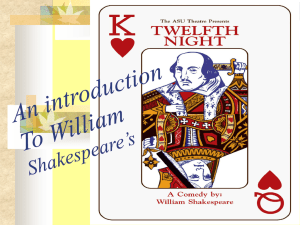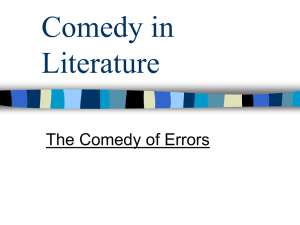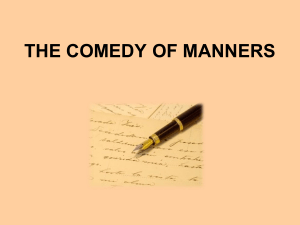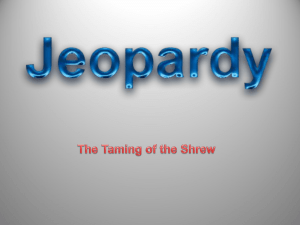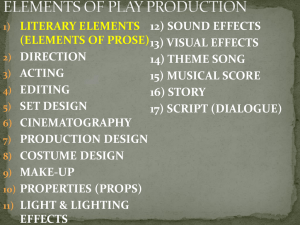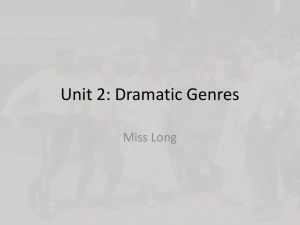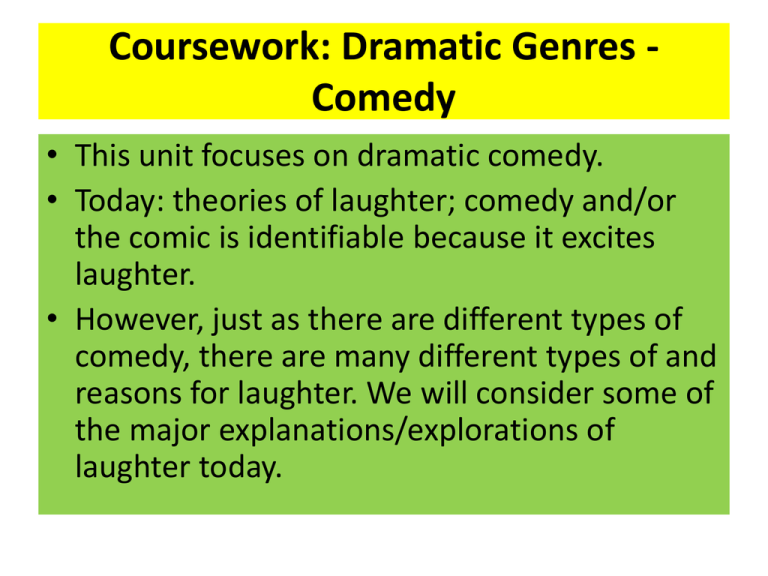
Coursework: Dramatic Genres Comedy
• This unit focuses on dramatic comedy.
• Today: theories of laughter; comedy and/or
the comic is identifiable because it excites
laughter.
• However, just as there are different types of
comedy, there are many different types of and
reasons for laughter. We will consider some of
the major explanations/explorations of
laughter today.
• What types of laughter are there?
• Why do we laugh?
Try to take some notes on the
following (warning: we will be
moving quite quickly)
• Laughter can be an indication of scorn, cruelty, harshness, mockery,
irreverence towards our “superiors” (rulers; the gods; God).
• Therefore treated by suspicion by many ancient philosophers :
Plato; Aristotle; the Stoics (emphasized self-control or selfdiscipline).
• In Christian tradition, at least until the C17, excessive laughter often
treated with suspicion.
• Long tradition of laughter seen as a vice; mockery a form of evil.
(Plato would not permit mocking poets into his ideal republic)
• But laughter also associated with pleasure.
• Pleasure and the negative associations of laughter not necessarily
at odds: schadenfreude – German word, first recorded 1922,
meaning (literally) “damage-laughter”; pleasure at others’
misfortunes.
Superiority Theory of Laughter
• The influential C17 philosopher Hobbes looked upon laughter negatively.
• Hobbes saw human existence as fundamentally individualistic and competitive;
laughter part and parcel of this. In his Leviathan, an influential work or moral
and political philosophy, he describes “the life of man” as “solitary, poor, nasty,
brutish, and short.”
• He later discusses laughter in the following term:
Sudden glory, is the passion which makes those grimaces called laughter; and is
caused either by some sudden act of their own, that pleases them; or by the apprehension
of some deformed thing in another, by comparison whereof they suddenly applaud
themselves. [...] And therefore much laughter at the defects of others, is a sign of
pusillanimity [extreme cowardice]. For of great minds, one of the proper works is, to help
and free others from scorn; and to compare themselves only with the most able.
• Hobbes’s view of laughter is central to what has become known as the
“Superiority Theory” of laughter.
• Popular theory, continued in C20 by people like Roger Scruton: “If people dislike
being laughed at it is surely because laughter devalues its object in the subject's
eyes”.
• Arguments against: Our sense of sudden/superiority might be expressed
otherwise than through laughter – e.g., pity, sadness, tears at witnessing people
less fortunate than ourselves. This argued by Francis Hutcheson in the C18.
Relief Theory of Laughter
•
•
•
•
•
•
•
•
•
Biological theory that laughter is one type of biological relief/release mechanism, much like
a pressure valve on a boiler. This theory dates back to C18, and is refined as science of
biology and anatomy develops.
Lord Shaftesbury, “An Essay on the Freedom of Wit and Humor” (1709); Herbert Spencer,
“On the Physiology of Laughter” (1860); John Dewey “The Theory of Emotion” (1894)
Spencer suggests that what sets laughter apart is that it has no “object”; no intention or
direction other than itself. E.g., anger/fear produce muscular movements, which in turn lead
to fight or flight; humour/amusement produces muscular movements which lead to laughter
– simply the release of energy with no other result/effect.
Freud, Jokes and their Relation to the Unconscious (1905); probably the most famous
formulation of a relief theory of laughter.
Freud suggests that laughter is an expenditure of excess energy – that is, energy summoned
for a particular task, which is then not needed. This surplus energy is expelled from the body
as laughter. He suggests three causes of the summoning of this energy:
Jokes: energy summoned to repress feelings
The comic: energy summoned to think/understand
Humour: energy summoned for emotions (e.g., to feel pity)
This theory has, largely, fallen out of favour:
– Not all laughter releases already pent-up emotion; that is, not all laughter is preceded by anticipatory
energy
– Freud relies on unconsciousness and repression; this does not explain comedy produced deliberately, by
writers and comedians; it does not even explain the comedy behind, for example, tricks and practical
jokes.
• More popular today is some version of the
Incongruity Theory:
• Associate with C18 philosophers such as
Beattie and Kant; C19 philosophers like
Schopenhauer, Kierkegaard; and with many
C20/C21 philosophers.
• Incongruity rests on a discrepancy between
our expectations and what actually happens
or is the case.
C18: Beattie and Kant
•
Beattie: “two or more inconsistent,
unsuitable, or incongruous parts or
circumstances, considered as united
in one complex object or assemblage,
as acquiring a sort of mutual relation
from the peculiar manner in which
the mind takes notice of them.”
•
•
Kant : Laughter arises from “the sudden
transformation of a strained expectation
into nothing.” That is, we derive
momentary pleasure from the straining
and then breaking of reality as we
understand/expect it, but this straining
and breaking (or “dissipation” as he calls
it) is of no consequence; we do not learn
anything from these moments.
Two jokes Kant uses to illustrate:
– The heir of a rich relative wished to arrange
for an imposing funeral, but he complained
that he could not properly succeed; “the
more money I give my mourners to look sad,
the more cheerful they look!”
– [A] merchant returning from India to Europe
with all his wealth in merchandise … was
forced to throw it overboard in a heavy storm
and … grieved thereat so much that his wig
turned gray the same night.
C19: Schopenhauer, Kierkegaard, Hazlitt
•
Kant’s idea rests on dislocation of our expectations and our actual experiences (our
enjoyment of the chance element of games is another example he uses). Schopenhauer
suggests a variation of this: laughter caused by the incongruity of our concept (or mental
picture) of a thing, and our individual perceptions of those things.
SHARK!!!
•
Kierkegaard focuses on the “contradiction” between what is expected and what is actually
experienced. He suggests that such contradiction is also a key element of tragedy. What
sets tragedy and comedy apart is that the former involves suffering, the latter does not:
– The tragic and the comic are the same, in so far as both are based on contradiction; but the tragic is the
suffering contradiction, the comical, the painless contradiction… . The comic apprehension evokes the
contradiction or makes it manifest by having in mind the way out, which is why the contradiction is
painless. The tragic apprehension sees the contradiction and despairs of a way out.
•
William Hazlitt also offers a similar distinction between tragedy and comedy:
– Man is the only animal that laughs and weeps: for he is the only animal that is struck with the
difference between what things are, and what they ought to be. We weep at what thwarts or exceeds
our desires in serious matters; we laugh at what only disappoints our expectations in trifles… . To
explain the nature of laughter and tears, is to account for the condition of human life; for it is in a
manner compounded of the two!
Incongruity it C20
• C20 philosophers have refined this model
slightly, saying that laughter is not the only
response to incongruity; rather, it suggests an
enjoyment of experiences of incongruity.
• Incongruity theories can also account for our
responses to jokes that rely on double or
ambiguous meanings:
– Mae West (actress): “Marriage is a great
institution, but I'm not ready for an institution”
Henri Bergson
• Henri Bergson, Laughter (1900): first book by a reputable philosopher. Does not
fit neatly into any of the “schools” of thought outlined so far(?), although it does
overlap with several of the ideas:
• Suggests that the phenomenon of laughter has at least three basic principles:
1.
2.
3.
•
it is fundamentally human;
that which produces laughter appeals to intelligence rather than feeling; it
therefore relies on a suspension of emotion (or “momentary anaesthesia”);
laughter is social/communal; when we laugh, we are part of a group that laughs
(“Laughter appears to stand in need of an echo”).
Most famous phrase from this extended essay is Bergson’s summary of the
comic: it consists in “something mechanical encrusted on the living.”
–
–
–
We laugh at people who are so rigid, mechanized, or automatic in what they do
and how they live, that they cannot successfully integrate into society.
Audiences are often induced to laugh at the awkward outsider; many comedies
track the gradual integration of the awkward outsider.
In a different way, there is also a source of comedy in the automaticity of the
human in certain contexts; highlights the mechanical aspects of our existence.
• Summarize the theories discussed.
• Watch this clip of Life of Brian. Which theories
might be applied to what we see?
References for Lessons 1: Philosophy of Laughter
General information and overview of philosophy of humour and laughter synthesized from:
Morreall, John (2012). “Philosophy of Humor.” The Stanford Encyclopedia of Philosophy (Spring 2013 Edition). Ed. Edward N. Zalta (ed.).
http://plato.stanford.edu/archives/spr2013/entries/humor/. Retrieved 05/09/13.
Smuts, Aaron (2009). “Humour.” Internet Encyclopedia of Philosophy. http://www.iep.utm.edu/humor/. Retrieved 05/09/13.
References to particular philosophers/theorists:
Beattie, James (1779). “Essay on Laughter and Ludicrous Composition.” Essays. 3rd ed. London.
Bergson, Henri (1900). Laughter: An Essay on the Meaning of the Comic. Trans. C. Brereton and F. Rothwell.
http://www.gutenberg.org/files/4352/4352-h/4352-h.htm. Retrieved 05/05/13.
Freud, Sigmund (1905). Jokes and Their Relation to the Unconscious. New York: London, 1974.
Hazlitt, William (1819). Lectures on the English Comic Writers. London: Oxford University Press, 1907.
Hobbes, Thomas (1651). Leviathan, New York: Penguin, 1982.
Kant, Immanuel (1790). Critique of Judgment. Trans. James Creed Meredith. Oxford: Clarendon Press, 1911.
Kierkegaard, Søren (1846). Concluding Unscientific Postscript. Trans. D. Swenson and W. Lowrie. Princeton: Princeton University Press, 1941.
Schopenhauer, Arthur (1818/1844). The World as Will and Idea. Trans. R. B. Haldane and J. Kemp. 6th ed. London: Routledge & Kegan Paul.,
1907.
Scruton, Roger (1986). “Laughter.” The Philosophy of Laughter and Humor. Ed. John Morreall. Albany: State University of New York Press. 156–
171.
Shaftesbury, Lord (1709). “Sensus Communis: An Essay on the Freedom of Wit and Humour. ” Characteristicks of Men, Manners, Opinions,
Times. 1st ed. London. 1711.
Spencer, Herbert (1911). “On the Physiology of Laughter.” Essays on Education, Etc. London: Dent.
For etymology (the origins and historical developments of the meanings of words):
Online Etymological Dictionary. http://www.etymonline.com/
Lesson 2
What’s so... funny
about Biggus Dickus?
What is so funny about
Biggus Dickus?
• Within the scene, there is a situation in which the
soldier need to repress their inappropriate laughter,
but can’t; this dynamic is neatly explained by the...?
• The repeated, rough but (more or less?)
inconsequential slapping of Brian, Brian’s corrections of
Pontius Pilate’s speech, and Pontius Pilate’s
characterization, the climax of the scene (also Pilate
and Centurion’s miscommunications?)...
• Do we laugh at Pilate’s speech? If so, an example of
which theory, perhaps?
History of Comedy
• Etymology of word “comedy”: revel’s song.
• Where does it come from?
• Aristotle, in his Poetics, says that comedy itself
far predates its best-known exponents.
• Comedy: as old as drama and the theatre
themselves?
Comedy & Tragedy
• One of two of the oldest forms of drama, other being
tragedy. The two forms are often compared/contrasted
(remember K_____), so it’s helpful to review one of the
better-known formulations of tragedy.
• Aristotle: “Tragedy, then, is an imitation of an action that is
serious, complete, and of a certain magnitude; in language
embellished with each kind of artistic ornament, the
several kinds being found in separate parts of the play; in
the form of action, not of narrative; through pity and fear
effecting the proper catharsis [purification and expulsion]
of these emotions.” (Poetics)
• He goes on to say that the appropriate protagonist of
tragedy is a man of noble birth, one who good and just, but
capable of honest mistakes.
Aristotle’s Poetics on comedy
Comedy, as we have said, is an imitation of persons worse
than the average. Their badness, however, does not extend
to the point of utter depravity; rather, ridiculousness is a
particular form of the shameful and may be described as the
kind of error and unseemliness that is not painful or
destructive. Thus, to take a ready example, the comic mask is
unseemly and distorted but expresses no pain.
(While the changes marking the development of tragedy, and
the persons responsible for them, did not pass unnoticed, no
attention was paid to comedy in its early stages because
comedy was not regarded as important [....] [W]hen there
begins to be any record of comic poets [...], comedy already
possessed its general outlines, and we do not who introduced
masks or prologues or the accepted number of actors or
anything of that sort. [...]) (Aristotle [1982], p.49)
Aristotle’s Poetics on comedy
• Some people believe that Aristotle intended/wrote a separate treatise on
comedy; some have even identified the anonymous Tractatus Coislinianus
(“Treatise on Comedy”) as one of Aristotle’s works, but this is not a point
of certainty or agreement.
• Interesting terminological point: the Greek term for the error of
protagonist of tragedy is hamartia; the term used for error of the
protagonist of comedy is hamartȇma. The first term suggests error
leading to pain, injury, harm destruction; the second suggests error
without this sense of threat.
(Taken from notes to Aristotle [1982], p.87)
• Interpretation: Aristotle’s point about the comic mask is interesting; we
should take it literally as a comic about the masks worn by actors, but we
can also read it as a metaphor that sums up what comedy should and
should not do (in Aristotle’s opinion).
Ancient Greek Comedy: Old Comedy (from Brown
[1992a] and Weitz [2009, pp. 39-62])
• Three periods of ancient Greek comedy: Old Comedy, Middle Comedy,
New Comedy; only a few examples of Old and New Comedy survive;
nothing of Middle Comedy.
• Aristophanes (446-386 BC) is the only writer of Greek Old Comedy whose
work is extant; Menander (341/2-290 BC) the only exponent of Greek New
Comedy.
• The Old Comedy of Aristophanes (based on Cam. Com. & VSI):
• Loosely structured; far less coherent/seamless than tragedy. Regular use
of the parabasis: chorus turns to the audience and directly addresses
them (e.g., on the role of/challenges facing the playwright); Aristophanes
uses parabasis to express his opinions to his audiences.
• Old Comedy lewd, scurrilous, satirical; aggressively attacked public figures;
“current affairs” focus particular to Athens and Athenian society; use of
grotesque costumes – padding around lower body to give actors
disproportionate shape; huge leather phalluses.
• Use of farce, slapstick, burlesque.
New Comedy of Menander (from Brown [1992a]
and Weitz [2009, pp. 39-62])
• Much gentler , with more general themes; far less
satirical and openly critical of public figures;
move towards themes of love and romance
(almost unheard of in Old Comedy).
• 2 reasons for this: Sparta’s defeat of Athens led
to less tolerant, less open society; theatre
performances spreading beyond Athens, means
more general appeal needed.
• With New Comedy we see the emergence of the
stock comic device of “slave whacking” (Weitz,
pp. 56-57).
Roman Comedy (from Brown [1992a] and Weitz
[2009, pp. 39-62])
• Main exponents to which we have access are Plautus and Terence.
• From them, we have a sense of Menander’s work, as Roman comedies
tended to rework many of the Greek comedies
• Plots of Roman comedies tended to involve subplots. These were
“borrowed” from various Greek plays, and would be added to a main plot
(often also taken from a Greek source). This practice especially associated
with Terence.
• Stock character of “witty slave,” or what George Duckworth calls the
serrus or “Clever Trickster and Faithful Servant” (Duckworth 1994, 24953).
• Common “plot-motifs of love, intrigue, and misunderstanding” (Brown
1992a, 839); chance meetings.
• Deliberate misuse of words for comic effect (would come to be called
malapropism in the C19).
• Plautus: his work includes examples of “jokes, puns, topical allusions,
audience address, and vulgarities of various kinds” (Brown 1992a).
However, did not practise political satire because of restrictive libel laws.
Medieval Comedy (Cuddon 1999, pp. 42223)
• In many ways less polished, rougher than comedies of
classical antiquity. English Mystery Plays (which
depicted religious concerns such as the Fall) involved
comic, even farcical interludes, which were designed
to entertain and break up the seriousness of the plays
(in France, farce was used to break up the liturgy).
• The Mystery Plays themselves became rougher and
“ruder” as they became gradually secularized, and
increasingly written in the vernacular.
• Characters tended to embody qualities of ideas (e.g.
Everyman), rather than “characters” as we would
understand the term today.
General Structure of Comedy
• Some would say that comedy is a
fairly conservative genre, which
follows the same basic structure:
exposition, complication,
resolution.
• Northrop Frye: “The theme of the
comic is the integration of
society, which usually takes the
form of incorporating a central
character into it.”
• Bergson suggests something
rather similar when he says that
comedy is a social phenomenon;
shared laughter marks us out as
part of a group (“Laughter
appears to stand in need of an
echo”).
• Perhaps more generously and
expansively, Matthew Bevis
suggests that one way of viewing
comedy is as “a mode through
which we organize our
knowledge of ourselves as
material beings who can revel in
and cast aspersions on our own
materiality” (Bevis 2013, p. 20).
Useful, broad distinctions:
• Low Comedy (Cuddon 1999, p.479): “A coarse (often
bawdy) type of comedy, sometimes used as comic
relief. The mirth it provokes is likely to come from the
belly rather than the brain. It commonly contains
buffoonery, slapstick, violent action and ribald jokes. It
is thus a crudely fundamental form which trades upon
people’s relish at seeing others humiliated and
ridiculed and involved in scabrous episodes.”
• High Comedy (Cuddon 1999, p.382): “A term
introduced by George Meredith in The Idea of Comedy
(1877). By it he meant a form of comedy of manners
marked by grace, wit and elegance; an urbane form
whose appeal was primarily to the intellect.”
The following notes are taken from
• Cuddon, J.A. The Penguin Dictionary of
Literary Terms and Literary Theory. London:
Penguin, 1999.
Commedia dell’arte
• Sixteenth-century Italian tradition of dramatic comedy
• Relies on:
–
–
–
–
–
Improvisation
Stock characters
Master/Servant, Mistress/Soubrette relationships
Physical comedy, clowning, buffoonery, farce
Often based around love intrigues
• Heavily improvised; followed generic/formulaic plots
• Influenced European (including English) drama, thanks
to travelling groups
Farce
• Farce = “stuffing” (French word; “farces” used to be
“stuffed” between acts of Mediaeval religious plays in
France)
• Plot driven (rather than character/dialogue driven)
• Associated with burlesque, though not identical with it
(perhaps lacks the mocking/parody element?)
• Form of low comedy:
– Slapstick/physical
– Improbable/impossible situations
– Complicated, rapidly developing plots
• Shakespeare’s The Taming of the Shrew and The Comedy of
Errors are among a very few known farces of their era
Satire
• Sometimes distinguished from “satirical comedy”
• A literary and dramatic tradition in which human and/or social folly
is mocked
• A form of (comic) protest
• Satirists often position themselves as moral/social reformers, or
guardians of moral standards/virtues
• Different traditions of satire, drawn from classical antiquity (ancient
Greece and Rome):
– Horatian Satire (Roman): Gentle form of satire; mocks people and/or
ideas
– Menippean Satire (Greek): Mocked the follies of humankind; used
elements of low comedy (e.g., parody and burlesque)
– Juvenalian Satire (Roman): “Angrier,” less reliant on wit than, e.g.,
Horatian Satire; more biting and scabrous (rough, “indecent”); more
“serious” in its moral outrage
Black Comedy
• From French comédie noire (early C20)
• A form or tradition of comedy that takes a
very dim, even despairing view of humanity
(e.g., the comedy in Pulp Fiction and In
Bruges?)
• A grim, often very biting form of comedy
• https://www.youtube.com/watch?v=ITU4fjSw
Tc0&list=PLzhdGOuKLrBFFR_5020xW9FubZSUdPGR
Presentations – Next Thursday
1. Comédie
2. Comedia dell’arte (+
comedia erudita)
3. Burlesque
4. Farce
5. Slapstick
6. Satire
7. Black comedy
• Origins (including
etymology/translation)
• History
• Characteristics
• Famous “literary” or
“artistic” examples
• Examples from
recent/popular culture
• PPts; handouts; posters
The IT Crowd
https://www.youtube.com/watch?v=Rq6HGt9
Prek
Includes a
protagonist,
antagonist and
tritagonist.
The IT Crowd
Stereotypes are
used.
Stereotypes are
used.
Love is a
motivating
force.
Social
convention is
proven to be
ridiculous.
An exposition is
followed by a
complication
and resolution.
It does not
involve “pain or
destruction”
and the
situations are
“laughable” –
Aristotle.
Includes downto-earth
humour and
physical
comedic
aspects.
References for Lesson 2: History of
Comedy
Aristotle [1982]. Poetics. Trans. James Hutton. New York: Norton, 1982.
Bevis, Matthew (2013). Comedy : A Very Short Introduction. Oxford: Oxford University Press.
Brown, Andrew (1992). “Greece, ancient.” Ed. Martin Banham, Martin . The Cambridge Guide to
Theatre. Rev. Ed. Cambridge: Cambridge University Press. 407-412.
Brown, Andrew (1992). “Rome.” Ed. Martin Banham, Martin . The Cambridge Guide to Theatre. Rev. Ed.
Cambridge: Cambridge University Press. 837-840.
Cuddon, J.A. (1999). The Penguin Dictionary of Literary Terms and Literary Theory. 4th Ed. London.
Duckworth, George (1994). The Nature of Roman Comedy. London: Bristol Classical.
Frye, Northrop (1957). Anatomy of Criticism: Four Essays. London: Penguin, 1990.
Weitz, Eric (2009). The Cambridge Introduction to Comedy. Cambridge: Cambridge University Press.
Lesson 3
• What is Shakespeare’s The Taming of the
Shrew about?
• What are its main themes (do you think)?
• Where is it set?
What is the function of the Inductions, and how do they relate
to the rest of the play? How do they affect the type of comedy
we understand The Taming of the Shrew to be?
• H/W: Answer this question, in full sentences,
with specific references (quotation and
analysis) from the Inductions.
Class & Land enclosures in the Tudor/Elizabethan Period
•
•
•
Land ownership and the condition of the land markets were the chief sources of wealth and
social status in the sixteenth and seventeenth centuries in England. (From Stephen
Greenblatt, “General Introduction,” The Norton Shakespeare, ed. Greenblatt (New York:
Norton, 1997), p. 7.)
Unease at social mobility led to sumptuary laws being passed: “Sumptuary laws were in
part a conservative attempt to protect the existing social order from upstarts. Social
mobility was not widely viewed as a positive virtue, and moralists repeatedly urged people
to stay in their place. Conspicuous consumption that was tolerated, even admired, in the
aristocratic elite was denounced as sinful and monstrous in less exalted social circles.”
(Greenblatt, p. 5.)
Thomas Smith, in the 1560s, described English social structure as consisting of four tiers:
“gentlemen, citizens, yeomen artificers, and labourer.” (Greeblatt, p. 7)
–
–
–
–
•
•
Gentlemen: royalty, nobility, knights, wealthy individuals who had attended university
Citizens: town officials, with civic responsibilities
Yeomen artificers: a measure of independence because they owned/controlled some land
Labourers: these people (men?) did serve on juries, hold church positions etc., but, according to Smith,
they were “the fourth sort of men which do not rule”; they have “no voice nor authority in our
commonwealth, and no account is made of them but only to be ruled.”
There were a number of riots in the London and Stratford regions, and around England,
during Shakespeare’s lifetime: against local leaders; for the release of prisoners; anti-alien
riots; and land enclosure riots. (From Greenblatt, p. 8.)
Women often involved in the enclosure riots, sometimes without their husbands (from
Greenblatt, p. 8).
Class & Land enclosures in the
Tudor/Elizabethan Period
In the Sly episode (Inductions 1 & 2):
• “Sly mentions Greet, an actual village near Stratford, and Burton Heath (possibly
Barton-on-the-Heath, another village close to Stratford), and the men
enumerated as his tavern companions – Stephen Sly, John Naps, Peter Turf, and
Henry Pimpernel – bear names marking them as English labouring types.
Moreover, the contrast between Sly and the Lord who carries him to his house
mirrors the gap in sixteenth-century rural England between poor labourers,
barely making a living at a succession of marginal jobs, and wealthy landowners.
As arable and common land was fenced in or enclosed to increase the
opportunities for grazing sheep, many landowners made huge profits, wool being
one of England’s most important exports. But enclosures, a number of which
occurred in the Stratford region, also caused hardship for small tenant farmers
forced off the enclosed land and in some cases driven into vagrancy.” (Jean E.
Howard, “The Taming of the Shrew,” The Norton Shakespeare, ed. Stephen
Greenblatt (New York: Norton, 1997), pp. 134-35.)
• Sly is known simply as “Beggar” in the earlier (First Folio) edition of the play.
• What is Sly’s profession?
Women in Shakespeare’s England (from Stephen Greenblatt, “General
Introduction,” The Norton Shakespeare, ed. Greenblatt (New York: Norton,
1997).
•
•
•
•
•
•
Despite being ruled by a female monarch, English women had relatively restricted lives; they were, in
general, “denied any rightful claim to institutional authority or personal autonomy” (Greenblatt, p.9).
Sir Thomas Smith: “we do reject women, as those whom nature hath made to keep home land to
nourish their family and children, and not to meddle with matters abroad, nor to bear office in a city
or commonwealth” (quoted in Greenblatt, p. 9). However, due perhaps to Elizabeth being the
monarch, he does allow that there are a few instances when “the blood is respected, not the age nor
the sex.”
Socially and economically, however, women in England enjoyed more freedom than those in Europe,
& were freer in the Elizabethan/Jacobean eras than they would be later on: “respectable women
could venture unchaperoned into the streets and attend the theatre. Single women, whether
widowed or unmarried, could, if they were of full age, inherit and administer land, make a will, sign a
contract, possess property, sue and be sued, without a male guardian or proxy. But married women
had no such rights under the common law.” (Greenblatt, p. 10.)
Writings about women at this time often used the analogy of a monarch ruling over a state to justify
the ideology of male domination/female submission. This conveniently ignored the sex of the
monarch, as well as the facts that 1) more women were unmarried than married at this time (because
single or widowed); 2) many women oversaw/took charge of domestic-commercial matters (e.g., the
making and market-selling of cheese, beer, etc.). (Taken from Greenblatt, p. 10)
Women who did not “fit” the expected mould were known as “scolds” and “shrews.”
Sexist moralisers would rail against women in print (in a type of writing known as polemic); a few
educated women answered with polemics of their own (e.g., “Jane Anger” and Jane Anger Her
Protection of Women [1589]).
• How does this knowledge of Elizabethan social
context inform our understanding of the
beginning of the play?
• If you were putting on a production of the
play, what difference do you think
keeping/discarding the frame narrative might
make?
3 possibilities for overall interpretation, then:
1. Katherine might be read not as “realistic” representation of a free,
independent woman, but as a symbol for land; the way she and Bianca
are treated might be seen as symbolic of the struggles over land and
land control that were brought about the land enclosures around the
Stratford area in Shakespeare’s day. Significantly, many women were
independently active in these riots.
2. Or, we might reverse this: we might see the “backdrop” of land disputes
and riots as a metaphor for the immoral way in which women were
treated. Maybe Shakespeare’s “farce” is actually a disguised social satire;
the play within a play structure helps mask/hide Shakespeare’s social
commentary.
3. The play is really about social mobility and class struggle; the land
enclosure problems are just one part of this (as land ownership was a
key source of wealth in Shakespeare’s day). The Inductions show class
difference and class conflict. Katherine, in the play within the play, might
be viewed as a symbol of the lower classes (or the “labourers”); this is
fitting, because women were very much second-class citizens, regardless
of whether they belonged to the Gentlemen, Citizen, Yeomen Artificer,
or Labourer class.
If any of these readings is convincing, we need to find textual
evidence to support them. So, let’s look for the language of
class, labour, wealth/profit/money.
• Induction 2; look especially at Sly’s lines, from
lines 5-73 (“I am Chistophero Sly” to “a pot
o’th’ smallest ale”).
• I.i: Lucentio and Tranio, lines 1-46 (and 188214).
• I.ii: Petruccio, lines 62-92; 191-205.
H/W: Re-read/re-watch the sections of Act I
from today; read Act II (only one scene); go
to the archive of In Our Time (BBC Radio 4), &
listen to the programme on Humanism:
http://www.bbc.co.uk/programmes/p00547
bk
H/W (04/10/13): After watching parts of film productions and reading Inductions and Act I, scene i.
Task
Write a short essay (approx. 600
words/two sides), answering questions
1-3 in the box opposite; use a computer
if possible. Question 1 needs a short
answer; so answers to questions 2 & 3
should be approx. 250-300 words each.
-You may refer to the film/theatre
productions where relevant. The filmed
theatre version is the American
Conservatory Theatre’s 1976 production,
directed by Kirk Browning; the film
version was made in 1967, was directed
by Franco Zeffirelli, and starred celebrity
couple Elizabeth Taylor and Richard
Burton.
- Use the PowerPoint slides from
pervious lessons to help set you
responses in context (so, refer to
different traditions/theories of comedy
where possible, and also the social
context of Shakespeare’s day).
1)
2)
3)
Begin by making a statement about what you
think The Taming of the Shrew is “about.” Do
not worry about feeling unsure at this early
stage, or about changing your mind as we go
on: The Taming of the Shrew is a comedy
about: a) class conflict; b) men’s ownership
of women; c) land reform, and the
disempowerment of the labouring classes in
Elizabethan England; d) the
disempowerment of women; e) marriage,
portrayed as a symbolic death/loss of
freedom; g) the importance of conforming to
social norms (hint: the Northrop Frye quote, if
you can find it on an earlier slide, might be
useful here).
Find three brief quotations from Inductions 1
& 2 and/or Act I, scene i, and analyse them in
detail, discussing how they might be
interpreted to support your response to (1).
Discuss the benefits/drawbacks, and reasons,
for including/excluding the Sly frame
narrative. Overall, do you think the play is
likely to work better with or without it? Why?
Try to use some of the notes on Elizabethan
social history (e.g., class, land ownership,
women’s status) to help you here.
What is the importance of language in The
Taming of the Shrew (with a focus on Petruchio
and Katherine’s first meeting, II.i)?
“Renaissance” Humanism
• A nineteenth-century invention; identifies and celebrates
the Italian Renaissance (C15) as the place of the birth of the
individual. (Most influential historian here is Jacob
Burckhardt.)
• Historians of culture, like Burckhardt, see the Renaissance
as the cradle of modernity, particularly because they see it
as a time in which a return to the teachings of Ancient
Greece and Rome (especially of Cicero) gives rise to a new
conception of the individual as something that has the
power of choice and free will; the idea of the individual
that emerges during the Renaissance is one that has the
capacity to shape and determine itself.
• (Of course, this capacity to shape oneself is usually
understood as God-given.)
Humanism and the Humanities
• The “Renaissance humanism” identified by C19th historians
is probably not one that the leading lights of the
Renaissance would themselves have recognised.
• To be a humanist in the C15-C17 meant to be one trained in
the so-called humanities.
• This meant schooling in the Classics of Greece and Rome; it
also meant training in rhetoric (the art of speaking well).
Eloquence was highly prized, and, for many, to speak well
was to understand well.
• Perhaps unsurprisingly, it was overwhelmingly men who
had access to such “humanist” education.
• A little confusingly, though, there is also a pronounced
tendency to view talk as feminine, action as masculine.
Sources of the humanist sense of self:
•
•
•
•
•
“Our bodies are our gardens, to the
which
our wills are gardeners” (Iago,
Othello)
“[You] may, by your own free will, to
whose custody We have assigned
you, trace for yourself the
lineaments of your own nature.”
(God speaking to Adam, as imagined
by Pico della Mirandola, in his
Oration on the Dignity o Man (an
essential statement of Renaissance
humanism.)
“there is nothing either good or bad,
but thinking makes it so” (Hamlet, in
Hamlet)
“Language most shows a man:
Speak, that I may see thee.” (Ben
Johnson, from Complete Poems).
•
•
•
•
“mere prattle, without practise, / Is all his
soldiership” (Iago, speaking of his rival Cassio in
Shakespeare’s Othello)
“Rude am I in my speech, / And little bless'd with
the soft phrase of peace” (Othello, in Othello)
“This is a way to kill a wife with kindness; / And
thus I'll curb her mad and headstrong humour.”
(Petruchio, Shrew)
“we do reject women, as those whom nature hath
made to keep home land to nourish their family and
children, and not to meddle with matters abroad,
nor to bear office in a city or commonwealth” (Sir
Thomas Smith, quoted in Greenblatt, p. 9). However,
due perhaps to Elizabeth being the monarch, he does
allow that there are a few instances when “the blood
is respected, not the age nor the sex.”
GRUMIO Will he woo her? ay, or I'll hang her.
PETRUCHIO Why came I hither but to that intent?
Think you a little din can daunt mine ears?
Have I not in my time heard lions roar?
Have I not heard the sea puff'd up with winds
Rage like an angry boar chafed with sweat?
Have I not heard great ordnance in the field,
And heaven's artillery thunder in the skies?
Have I not in a pitched battle heard
Loud 'larums, neighing steeds, and trumpets' clang?
And do you tell me of a woman's tongue,
That gives not half so great a blow to hear
As will a chestnut in a farmer's fire?
Tush, tush! fear boys with bugs.
• So, what do we make of Baptista’s decision to
school his daughter in music, mathematics,
science, and the Classics?
• (The significance of the books Tranio presents
to Baptista…)
• (Significance of Cambio’s name…)
Virtue
PETRUCHIO And you, good sir! Pray, have
you not a daughter
Call'd Katharina, fair and virtuous?
BAPTISTA I have a daughter, sir, called
Katharina.
PETRUCHIO You lie, in faith; for you are
call'd plain Kate,
And bonny Kate and sometimes Kate the
curst;
But Kate, the prettiest Kate in Christendom
Kate of Kate Hall, my super-dainty Kate,
For dainties are all Kates, and therefore,
Kate,
Take this of me, Kate of my consolation;
Hearing thy mildness praised in every town,
Thy virtues spoke of, and thy beauty
sounded,
Yet not so deeply as to thee belongs,
Myself am moved to woo thee for my wife.
virtue (n.) early 13c., "moral life
and conduct, moral excellence,"
vertu, from Anglo-French and
Old French vertu, from Latin
virtutem (nominative virtus)
"moral strength, manliness,
valor, excellence, worth," from
vir "man" (see virile). (From the
Online Etymological Dictionary)
Returning first Shrew essays
General feedback (notes if relevant to you)
• Everyone between 1 and 2 grades off end of year target. This is actually NOT
BAD at this stage, believe it or not!
• Often, the difference between of D/C, C/B, B/A, is the difference of only a
sentence or two, but a sentence or two per paragraph.
• Word-/phrase-level analysis: more needed from everyone, regardless of final
grade. The more in-depth the analysis of language, the better the essay will be
overall.
• Integration of history/theory: More of this from everyone. You should not write
“bolt-on” history/theory essays; but you should demonstrate is some detail your
understanding of the history/theory of comedy.
• Alternative interpretations: explore these where possible; gains marks for AO3
(interpretations – yours and others’), and a good way to expand analyses.
• If you’re one grade away from where you want to be, it’s mostly a case of
expansion – more detail in analyses/interpretation.
• If you’re two grades away, you’re probably hinting at but not clearly showing
your knowledge/understanding. This is to do with structure of the essay, and
clarity of writing.
Summary, Explanation, Analysis
• Summary: “This happens, then this, then this. So-AndSo says…, so What’s-Her-Name replies…” (E/D)
• Explanation: Brief summary (“When So-And-So says…,
X happens.” [1-2 sentences]). Quote, followed by brief
explanation (“This means that…”). (D)
• Analysis: “This word/phrase could suggest…, because…
Equally, it has connotations of… The way audiences
interpret this word/phrase/line depends on…” (C &
above, depending on detail and quality)
Baptista refuses to “bestow my youngest daughter / Before I have a husband
for the elder” (I.i).
1. Baptista refuses to “bestow my youngest daughter / Before I have a husband for the elder”
(I.i). This means he will not allow Bianca to marry before Katherina – the “shrew” – has
married.
2. Baptista refuses to “bestow my youngest daughter / Before I have a husband for the elder”
(I.i). This means he will not allow Bianca to marry before Katherina – the “shrew” – has
married. Therefore we can see that women were not treated well; their husbands and fathers
saw them as objects to be traded.
3. Baptista refuses to “bestow my youngest daughter / Before I have a husband for the elder”
(I.i). The word “bestow” means to offer something as a gift, and so we can see from Baptista’s
language that women were viewed by their father’s and husbands not as free, independent
individuals, but as valuable “objects” to be traded.
4. Baptista refuses to “bestow my youngest daughter / Before I have a husband for the elder”
(I.i). The word “bestow” means to offer something as a gift, and so we can see from Baptista’s
language that women were viewed by their father’s and husbands not as free, independent
individuals, but as valuable “objects” to be traded. Interestingly, “bestow” derives from
“stow,” which suggests the storing of cargo in a ship. Petruchio also uses the language of cargo
and trade when he speaks of metaphorically of “boarding” Katherina, and of the “burden” of
his search for a wife. “Burden” has musical connotations, but also suggests the cargo capacity
of a ship. Men’s language, when speaking of women, is infused with images of cargo, goods,
and trade.
The same, with a little context:
Baptista refuses to “bestow my youngest daughter / Before I have a husband for the
elder” (I.i). The word “bestow” means to offer something as a gift, and so we can see
from Baptista’s language that women were viewed by their father’s and husbands not
as free, independent individuals, but as valuable “objects” to be traded. This was not
an uncommon belief in Shakespeare’s day. Sir Thomas Smith, a member of Queen
Elizabeth’s court, believed that a woman’s place was very much in the home, and
that women had no part to play in public or social life (this, despite the fact that
women of the labouring classes often oversaw commercial as well as domestic
matters). “We do reject women,” he wrote, “as those whom nature hath made to
keep home land to nourish their family and children, and not to meddle with matters
abroad, nor to bear office in a city or commonwealth” (quoted in Greenblatt, p. 9).
Baptista, Petruchio, and the other men in Shrew certainly do not challenge Smith’s
views. If anything, they go further in their objectification of women. “Bestow”
derives from “stow,” which suggests the storing of cargo in a ship. Petruchio also uses
the language of cargo and trade when he speaks of metaphorically of “boarding”
Katherina, and of the “burden” of his search for a wife. “Burden” has musical
connotations, but also suggests the cargo capacity of a ship. We can see, then, that
men’s language, when speaking of women, is infused with images of cargo, goods, and
trade.
From this: Baptista refuses to “bestow my youngest daughter / Before I have a
husband for the elder” (I.i). This means he will not allow Bianca to marry before
Katherina – the “shrew” – has married.
To this:
Baptista refuses to “bestow my youngest daughter / Before I have a husband for the
elder” (I.i). The word “bestow” means to offer something as a gift, and so we can see
from Baptista’s language that women were viewed by their father’s and husbands not as
free, independent individuals, but as valuable “objects” to be traded. This was not an
uncommon belief in Shakespeare’s day. Sir Thomas Smith, a member of Queen Elizabeth’s
court, believed that a woman’s place was very much in the home, and that women had
no part to play in public or social life (this, despite the fact that women of the labouring
classes often oversaw commercial as well as domestic matters). “We do reject women,”
he wrote, “as those whom nature hath made to keep home land to nourish their family
and children, and not to meddle with matters abroad, nor to bear office in a city or
commonwealth” (quoted in Greenblatt, p. 9). Baptista, Petruchio, and the other men in
Shrew certainly do not challenge Smith’s views. If anything, they go further in their
objectification of women. “Bestow” derives from “stow,” which suggests the storing of
cargo in a ship. Petruchio also uses the language of cargo and trade when he speaks of
metaphorically of “boarding” Katherina, and of the “burden” of his search for a wife.
“Burden” has musical connotations, but also suggests the cargo capacity of a ship. We can
see, then, that men’s language, when speaking of women, is infused with images of cargo,
goods, and trade.
• Pick a section of your
essay, and rewrite it.
Homework:
How is language used in
Petruchio and Katherina’s
first meeting (II.i)?
600-700 words (approx. 2
sides)
As
flirtation/foreplay/weapon
/instrument of power or
domination
2 Lessons: Katherine’s last speech
• Textual analysis and discussion
– Links to Petruccio’s speeches in Acts I and III:
“Have I not braved...” (Katherine’s language
repeats many of the figures P uses here); on
leaving the wedding party, “She is my chattels, my
house...” (K’s speech endorses this from “the
other side”: “husband is thy lord, thy master...”)
• Compare two productions; make notes on
language and performance.
H/W
• Pick 2 questions that you think you might consider for the
coursework.
• Select key scenes (no more than 3), and from them key
quotations, that you think will help you answer the
questions.
• Review/revise the PPt slides, so that you can consider the
critical and contextual points that will also help to answer
the questions (Aos 3 & 4)
• TIP: For quick navigation of the whole play, got to
http://shakespeare.mit.edu/taming_shrew/full.html, and
search key words/phrases, then identify the relevant
words/phrases/sections in your copy of the play.
Linguistic Patterns in Katherine’s
speech
• Body (humanism/the
self)
• Nature/land
• (Manly virtue?) (Links to
P’s speeches?)
• Possession
• Religion/sovereignty
• Politics (“head”)
• K’s speech is:
• an admission of defeat
• an incitement to quiet
subversion
• an incitement to
rebellion
• an extended sociopolitical metaphor
1.
2.
3.
4.
5.
6.
7.
8.
“The theme of the comic is the integration of society, which usually takes the form of
incorporating a central character into it.” (Northrop Frye) Shakespeare’s The Taming of
the Shrew is a conservative comedy that presents the virtues of societal conformism.
Discuss.
“It is hard to say what kind of comedy Shakespeare’s The Taming of the Shrew is. If it
makes us laugh at all, the reasons for our laughter will change as our social and moral
codes change.” Discuss.
“Shakespeare’s The Taming of the Shrew is not a comedy about ‘the battle of the sexes.’
In this play, sex and gender are versatile symbols that stand for other contemporary
concerns.” Discuss.
“Our bodies are our gardens, to the which our wills are gardeners” (Iago, in
Shakespeare’s Othello). Shakespeare’s The Taming of the Shrew is a comedy about the
importance and difficulties of self-fashioning and self-determination. Discuss.
“This is a way to kill a wife with kindness.” “If a comedy at all, Shakespeare’s The Taming
of the Shrew can, today, only be understood as a black comedy about the symbolic
death of a naturally independent woman.” Discuss.
“In token of which duty, if he please, / My hand is ready; may it do him ease.” In
Shakespeare’s comedy The Taming of the Shrew, to what extent is Katherine’s final
speech an admission of defeat?
PETRUCHIO Who knows not where a wasp does
wear his sting? In his tail.
KATHARINA In his tongue.
“Shakespeare’s comedy The Taming of the Shrew explores the power and danger of
language. Katherine’s great ‘crime’ is that dares to speak.” Discuss.
“Everything that Shakespeare’s comedy The Taming of the Shrew is about is in the
Inductions. Without these, teh play is merely farce. With them, it is a profound social
commentary and critique.” Discuss.
Lessons on CW preparation
Lesson 1
Planning Coursework (1)
• Which question(s) will you choose?
• What is your initial response to the question?
1.
2.
3.
4.
5.
6.
7.
8.
“The theme of the comic is the integration of society, which usually takes the form of
incorporating a central character into it.” (Northrop Frye) Shakespeare’s The Taming of
the Shrew is a conservative comedy that presents the virtues of societal conformism.
Discuss.
“It is hard to say what kind of comedy Shakespeare’s The Taming of the Shrew is. If it
makes us laugh at all, the reasons for our laughter will change as our social and moral
codes change.” Discuss.
“Shakespeare’s The Taming of the Shrew is not a comedy about ‘the battle of the sexes.’
In this play, sex and gender are versatile symbols that stand for other contemporary
concerns.” Discuss.
“Our bodies are our gardens, to the which our wills are gardeners” (Iago, in
Shakespeare’s Othello). Shakespeare’s The Taming of the Shrew is a comedy about the
importance and difficulties of self-fashioning and self-determination. Discuss.
“This is a way to kill a wife with kindness.” “If a comedy at all, Shakespeare’s The Taming
of the Shrew can, today, only be understood as a black comedy about the symbolic
death of a naturally independent woman.” Discuss.
“In token of which duty, if he please, / My hand is ready; may it do him ease.” In
Shakespeare’s comedy The Taming of the Shrew, to what extent is Katherine’s final
speech an admission of defeat?
PETRUCHIO Who knows not where a wasp does
wear his sting? In his tail.
KATHARINA In his tongue.
“Shakespeare’s comedy The Taming of the Shrew explores the power and danger of
language. Katherine’s great ‘crime’ is that dares to speak.” Discuss.
“Everything that Shakespeare’s comedy The Taming of the Shrew is about is in the
Inductions. Without these, teh play is merely farce. With them, it is a profound social
commentary and critique.” Discuss.
• Get into groups with people working on the
same question(s) as you.
• What is your initial response to the question?
• Don’t worry about a variety of responses;
write out the initial responses as statements
(1-3 sentences). E.g., I agree with that…,
because…
• TIP: It’s sometimes useful to pick a statement
you disagree with.
• Which sections of the play, and which
characters will you need to focus on, in order
to answer your question? Make a note of
these on your paper. Use Act, scene, and line
numbers (the latter where necessary).
• Now go back to your initial statements.
• Rewrite, in your books, and expand:
– How do respond to the question (agree/disagree)?
– Why?
– How will you argue your opinion? (E.g., I will focus
on…)
• Character
• Sections/speeches
• Historical context
Finally…
• Do you have the makings/beginnings of a
strong, focussed introduction?
• Does you introduction have a thesis/argument
at its centre?
Planning Coursework (2): Analysis
• Finalise your initial statements.
• Be ready to read them out.
Context
Context is important, but only the contextual
detail that affects your understanding of the
play.
For example, do the following pieces of
information affect your interpretations?
• Sly is known simply as “Beggar” in the earlier
(First Folio) edition of the play.
• Shakespeare was born in Stratford-upon-Avon
in Warwickshire and was baptised a few days
later on 26 April 1564. His father, John
Shakespeare, was a glove maker and wool
merchant and his mother, Mary Arden, was
the daughter of a well-to-do landowner from
Wilmcote, South Warwickshire. It is likely
Shakespeare was educated at the local King
Edward VI Grammar School in Stratford.
From Stephen Greenblatt, “General Introduction,” The Norton
Shakespeare, ed. Greenblatt (New York: Norton, 1997)
• Unease at social mobility led to sumptuary laws being
passed: “Sumptuary laws were in part a conservative
attempt to protect the existing social order from
upstarts. Social mobility was not widely viewed as a
positive virtue, and moralists repeatedly urged people
to stay in their place. Conspicuous consumption that
was tolerated, even admired, in the aristocratic elite
was denounced as sinful and monstrous in less
exalted social circles.” (Greenblatt, p. 5.)
• Sumptuary laws included the sorts of clothes it was
deemed acceptable for people of the different classes
to wear. However, these laws were very difficult to
enforce.
• There were a number of riots in the London
and Stratford regions, and around England,
during Shakespeare’s lifetime: against local
leaders; for the release of prisoners; anti-alien
riots; and land enclosure riots. (From
Greenblatt, p. 8.)
• Women often involved in the enclosure riots,
sometimes without their husbands (from
Greenblatt, p. 8).
Ongoing H/W as you prepare the
coursework
• Check the relevant history/context slides on
the PPt.
• Start researching context on your own. Begin
with the internet – plenty of information on
Shakespeare in the cybersphere.
• 1 paragraph of analysis.
• Be as focussed as possible.
• Be ready to swap with a partner.
• Remember: history of comedy and theories of
laughter count as context and critical opinion.
Baptista refuses to “bestow my youngest daughter / Before I have a husband
for the elder” (I.i).
1. Baptista refuses to “bestow my youngest daughter / Before I have a husband for the elder”
(I.i). This means he will not allow Bianca to marry before Katherina – the “shrew” – has
married.
2. Baptista refuses to “bestow my youngest daughter / Before I have a husband for the elder”
(I.i). This means he will not allow Bianca to marry before Katherina – the “shrew” – has
married. Therefore we can see that women were not treated well; their husbands and fathers
saw them as objects to be traded.
3. Baptista refuses to “bestow my youngest daughter / Before I have a husband for the elder”
(I.i). The word “bestow” means to offer something as a gift, and so we can see from Baptista’s
language that women were viewed by their father’s and husbands not as free, independent
individuals, but as valuable “objects” to be traded.
4. Baptista refuses to “bestow my youngest daughter / Before I have a husband for the elder”
(I.i). The word “bestow” means to offer something as a gift, and so we can see from Baptista’s
language that women were viewed by their father’s and husbands not as free, independent
individuals, but as valuable “objects” to be traded. Interestingly, “bestow” derives from
“stow,” which suggests the storing of cargo in a ship. Petruchio also uses the language of cargo
and trade when he speaks of metaphorically of “boarding” Katherina, and of the “burden” of
his search for a wife. “Burden” has musical connotations, but also suggests the cargo capacity
of a ship. Men’s language, when speaking of women, is infused with images of cargo, goods,
and trade.
The same, with a little context:
Baptista refuses to “bestow my youngest daughter / Before I have a husband for the
elder” (I.i). The word “bestow” means to offer something as a gift, and so we can see
from Baptista’s language that women were viewed by their father’s and husbands not
as free, independent individuals, but as valuable “objects” to be traded. This was not
an uncommon belief in Shakespeare’s day. Sir Thomas Smith, a member of Queen
Elizabeth’s court, believed that a woman’s place was very much in the home, and
that women had no part to play in public or social life (this, despite the fact that
women of the labouring classes often oversaw commercial as well as domestic
matters). “We do reject women,” he wrote, “as those whom nature hath made to
keep home land to nourish their family and children, and not to meddle with matters
abroad, nor to bear office in a city or commonwealth” (quoted in Greenblatt, p. 9).
Baptista, Petruchio, and the other men in Shrew certainly do not challenge Smith’s
views. If anything, they go further in their objectification of women. “Bestow”
derives from “stow,” which suggests the storing of cargo in a ship. Petruchio also uses
the language of cargo and trade when he speaks of metaphorically of “boarding”
Katherina, and of the “burden” of his search for a wife. “Burden” has musical
connotations, but also suggests the cargo capacity of a ship. We can see, then, that
men’s language, when speaking of women, is infused with images of cargo, goods, and
trade.
From this: Baptista refuses to “bestow my youngest daughter / Before I have a
husband for the elder” (I.i). This means he will not allow Bianca to marry before
Katherina – the “shrew” – has married.
To this:
Baptista refuses to “bestow my youngest daughter / Before I have a husband for the
elder” (I.i). The word “bestow” means to offer something as a gift, and so we can see
from Baptista’s language that women were viewed by their father’s and husbands not as
free, independent individuals, but as valuable “objects” to be traded. This was not an
uncommon belief in Shakespeare’s day. Sir Thomas Smith, a member of Queen Elizabeth’s
court, believed that a woman’s place was very much in the home, and that women had
no part to play in public or social life (this, despite the fact that women of the labouring
classes often oversaw commercial as well as domestic matters). “We do reject women,”
he wrote, “as those whom nature hath made to keep home land to nourish their family
and children, and not to meddle with matters abroad, nor to bear office in a city or
commonwealth” (quoted in Greenblatt, p. 9). Baptista, Petruchio, and the other men in
Shrew certainly do not challenge Smith’s views. If anything, they go further in their
objectification of women. “Bestow” derives from “stow,” which suggests the storing of
cargo in a ship. Petruchio also uses the language of cargo and trade when he speaks of
metaphorically of “boarding” Katherina, and of the “burden” of his search for a wife.
“Burden” has musical connotations, but also suggests the cargo capacity of a ship. We can
see, then, that men’s language, when speaking of women, is infused with images of cargo,
goods, and trade.
H/W
• Write up intro.

